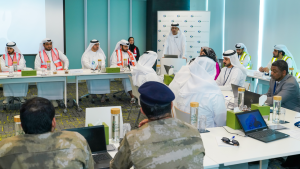ABU DHABI/ AD MEDIA OFFICE
The Environment Agency – Abu Dhabi (EAD) has conducted a tabletop exercise that explored possible responses to red tide and fish kill events in coordination with the Emergencies, Crises and Disaster Management Centre Abu Dhabi (ADCMC).
The exercise gathered a total of 16 Abu Dhabi Government entities to test their readiness to confront and respond quickly and effectively to threats and emergencies caused by the risk of red tide and fish kills in the emirate.
Khaled Mohammed Al Hajri, Director of the Emergency, Safety and Business Continuity Office at EAD, said: “The EAD is the leading entity regarding the risk of red tide and fish kills based on the emirate’s local risk register – an integral part of the integrated system for emergency, crisis and disaster management at the local level in Abu Dhabi. This system aims to raise the readiness of the concerned entities to confront and respond quickly and effectively to emergency situations and threats of all kinds.”
He emphasised that during the simulation exercise various possible scenarios were reviewed. He also highlighted the importance of committing work teams from each government entity to activate the general response plan for red tide events and fish deaths.
By conducting such exercises, EAD seeks to achieve several main objectives, including raising the readiness of relevant work teams and assigning roles and responsibilities, while increasing the teams’ experience and skills development,
The objectives also aim to raises the readiness of assets and resources required to support emergency and crisis operations by testing the efficiency of mechanisms, equipment, and smart systems for exchanging information and financial resources required to respond in emergency and crisis situations. This is achieved by measuring the extent of the systems’ compatibility and the availability of resources during response operations.
The exercises also aim to raise the quality of the planning, preparedness, and institutional readiness process by measuring how effectively the emergency response plan was implemented, while raising the quality of the emergency response and recovery process by measuring the speed and effectiveness of response procedures, investigating event data, collecting evidence, and following up on recovery processes. The exercises also help to identify the most affected areas by assessing the likelihood of future risks and determining their severity to develop appropriate proactive mitigation measures, as well as to identify strengths and opportunities for continual improvement during emergency situations in accordance with the best local and international practices and standards related to aspects of the emergency and crisis system.
The exercise included interactive discussion sessions during which ideas and experiences were exchanged, and a set of practical recommendations were presented to comprehensively improve the quality of marine water sustainably. Recommendations included enhancing cooperation between the public and private sectors, the application of modern water treatment technologies, and raising community awareness of the importance of preserving the marine environment.
 The Gulf Time Newspaper One of the finest business newspapers in the UAE brought to you by our professional writers and editors.
The Gulf Time Newspaper One of the finest business newspapers in the UAE brought to you by our professional writers and editors.
